Abstract
1 The positive inotropic and chronotropic responses to sympathomimetic amines were examined in guinea-pig isolated atria. 2 The order of potency measured from EC50 values was isoprenaline greater than orciprenaline greater than salbutamol greater than or equal to fenoterol greater than terbutaline. Terbutaline and salbutamol were partial agonists on rate and together with orciprenaline and fenoterol also on tension responses. 3 Functional antagonism by carbachol caused a rightwards shift of the dose-response curve and depression of the maximum response. The rate maxima for orciprenaline, fenoterol and terbutaline were above that of isoprenaline. All the tension maxima were below isoprenaline. 4 Dissociation constants (KA) and relative efficacies (er) were determined by analogy with irreversible antagonism. 5 The relative orders of affinity (KA) were isoprenaline greater than orciprenaline greater than fenoterol greater than salbutamol greater than terbutaline. Affinities were identical on rate and tension. 6 The relative efficacies were all greater than isoprenaline for rate responses. On tension they were the same or less than isoprenaline. 7 The implications of these results are discussed, in particular the fact that a partial agonist has a greater efficacy than a full agonist.
Full text
PDF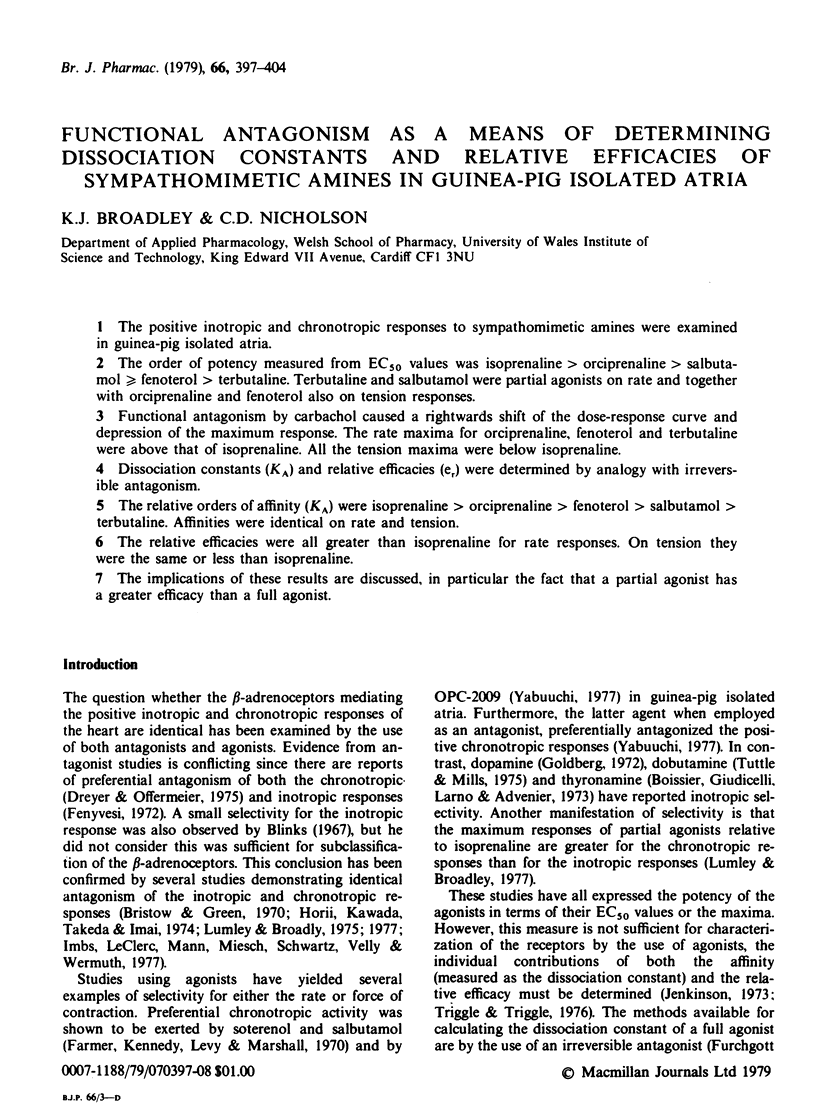
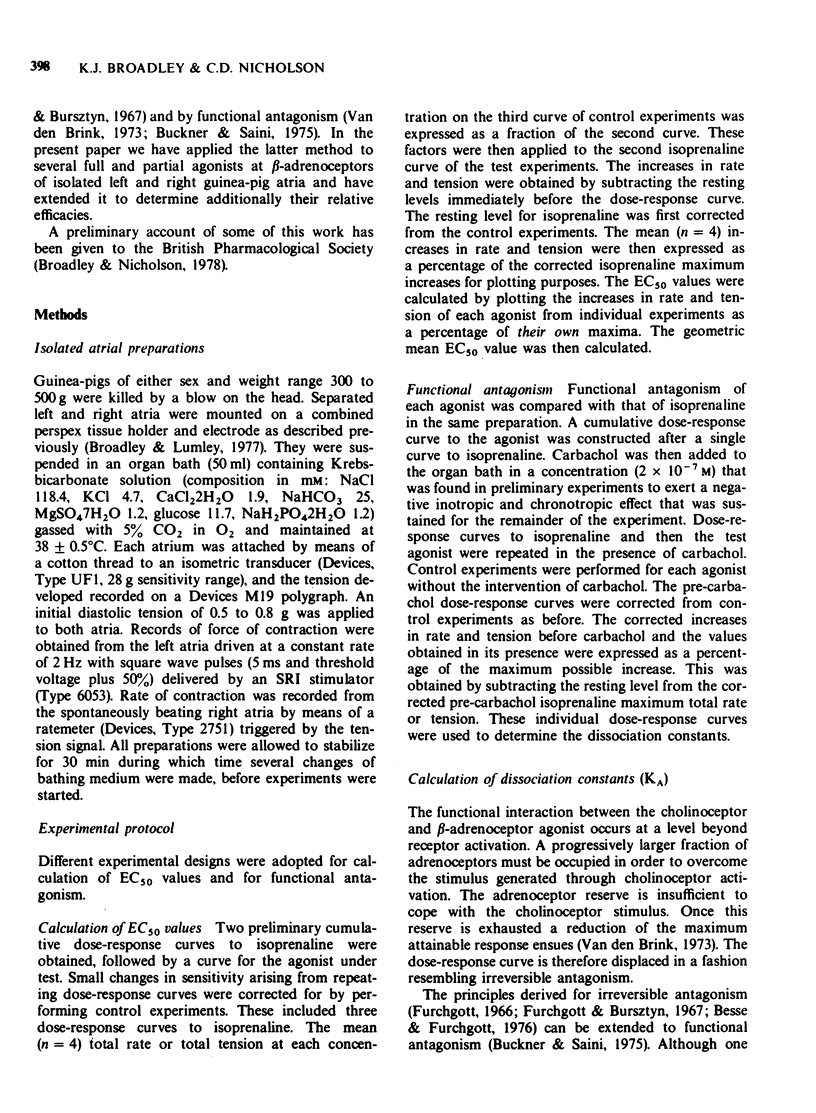
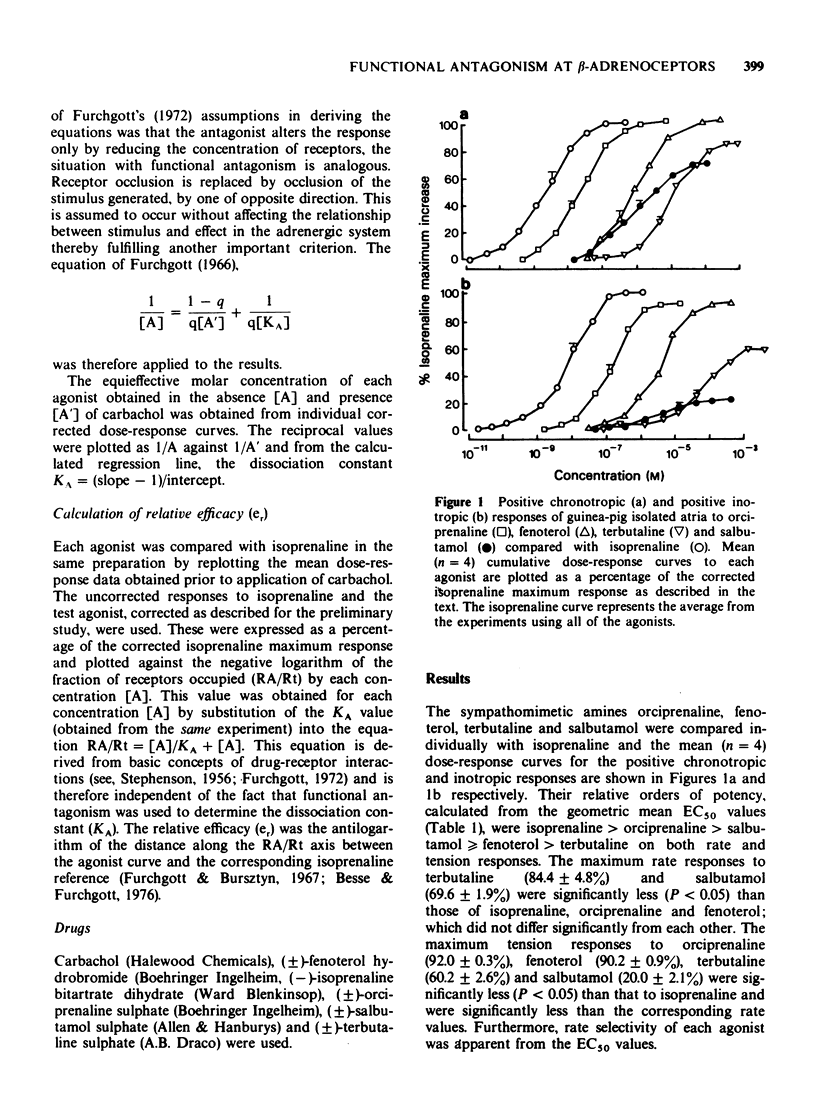
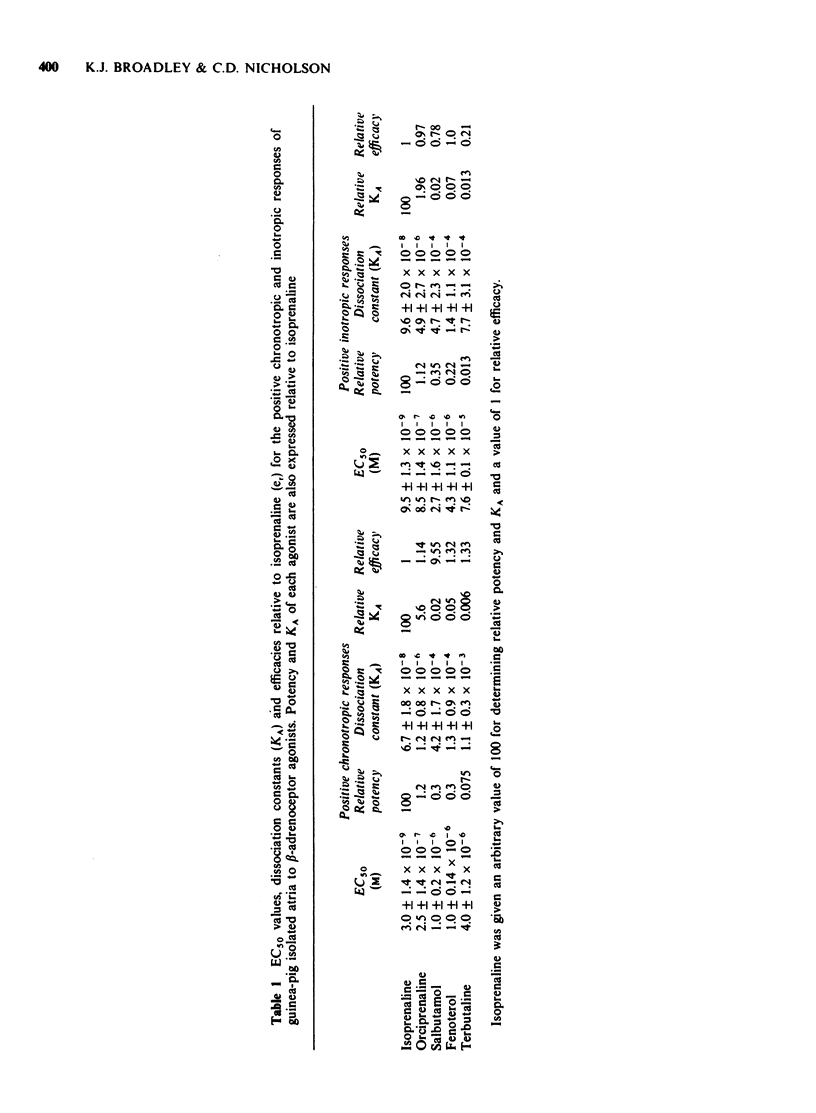
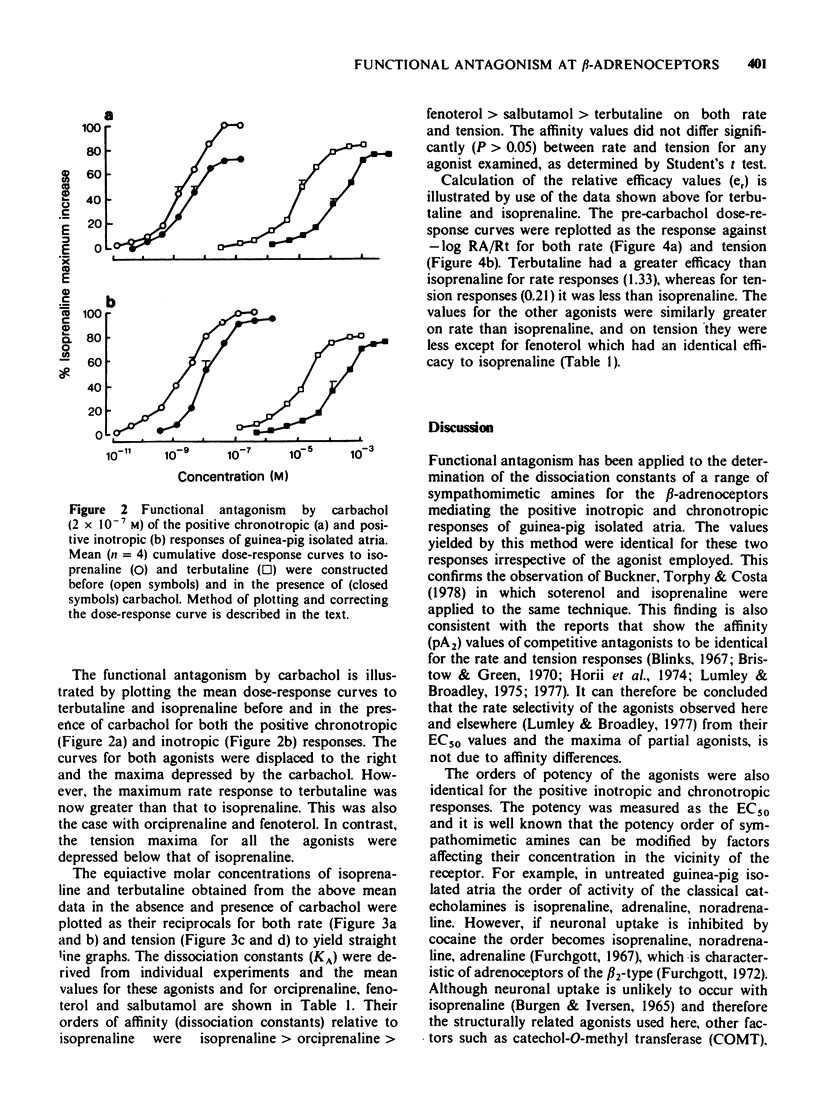
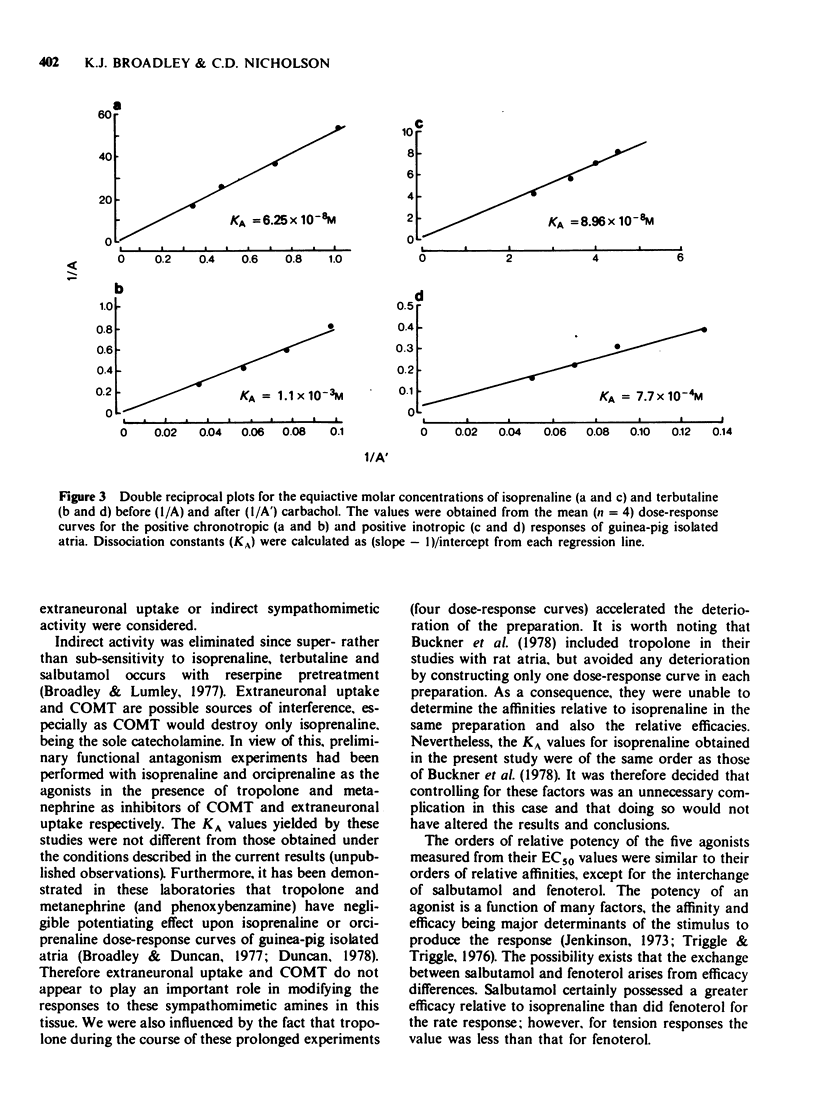
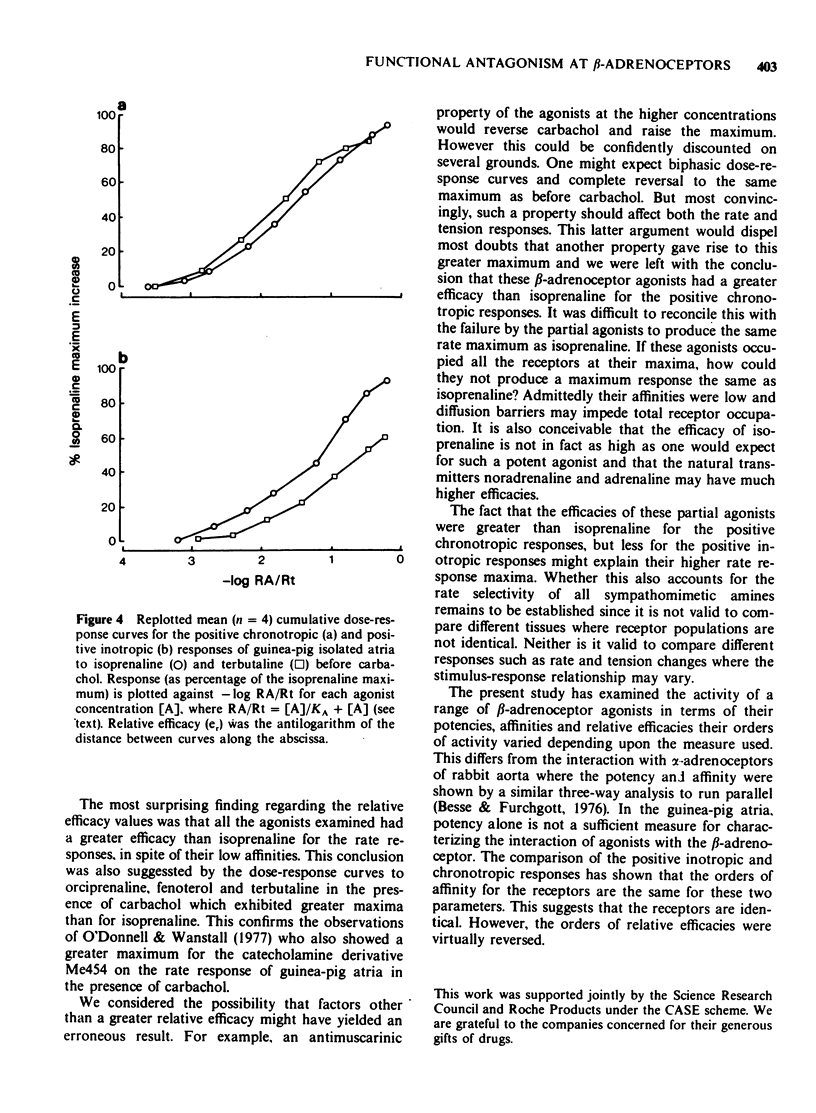
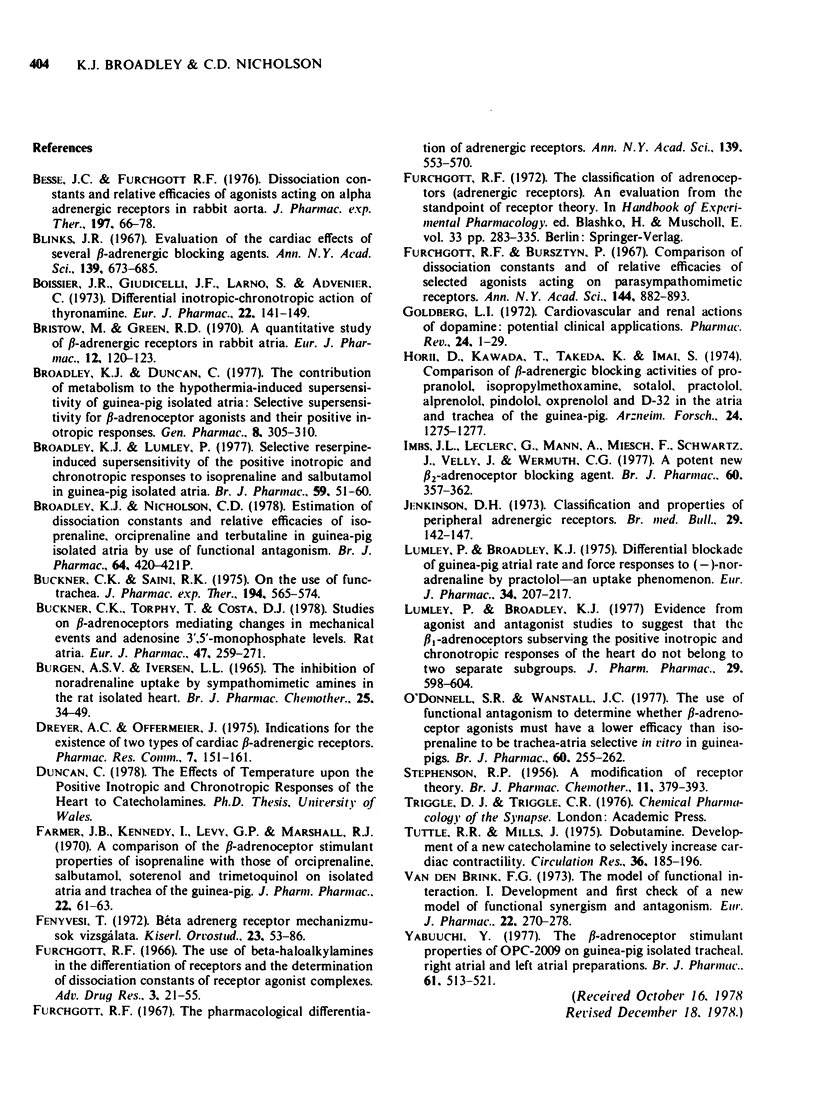
Selected References
These references are in PubMed. This may not be the complete list of references from this article.
- Besse J. C., Furchgott R. F. Dissociation constants and relative efficacies of agonists acting on alpha adrenergic receptors in rabbit aorta. J Pharmacol Exp Ther. 1976 Apr;197(1):66–78. [PubMed] [Google Scholar]
- Blinks J. R. Evaluation of the cardiac effects of several beta adrenergic blocking agents. Ann N Y Acad Sci. 1967 Feb 10;139(3):673–685. doi: 10.1111/j.1749-6632.1967.tb41237.x. [DOI] [PubMed] [Google Scholar]
- Boissier J. R., Giudicelli J. F., Larno S., Advenier C. Differential inotropic--chronotropic action of thyronamine. Eur J Pharmacol. 1973 May;22(2):141–149. doi: 10.1016/0014-2999(73)90004-6. [DOI] [PubMed] [Google Scholar]
- Bristow M., Green R. D. A quantitative study of beta-adrenergic receptors in rabbit atria. Eur J Pharmacol. 1970 Sep 1;12(1):120–123. doi: 10.1016/0014-2999(70)90037-3. [DOI] [PubMed] [Google Scholar]
- Broadley K. J., Duncan C. The contribution of metabolism to the hypothermia-induced supersensitivity of guinea-pig isolated atria; selective supersensitivity for beta-adrenoceptor agonists and their positive inotropic responses. Gen Pharmacol. 1977;8(5-6):305–310. doi: 10.1016/0306-3623(77)90004-0. [DOI] [PubMed] [Google Scholar]
- Broadley K. J., Lumley P. Selective reserpine-induced supersensitivity of the positive inotropic and chronotropic responses to isoprenaline and salbutamol in guinea-pig isolated atria. Br J Pharmacol. 1977 Jan;59(1):51–60. doi: 10.1111/j.1476-5381.1977.tb06976.x. [DOI] [PMC free article] [PubMed] [Google Scholar]
- Buckner C. K., Saini R. K. On the use of functional antagonism to estimate dissociation constants for beta adrenergic receptor agonists in isolated guinea-pig trachea. J Pharmacol Exp Ther. 1975 Sep;194(3):565–574. [PubMed] [Google Scholar]
- Buckner C. K., Torphy T., Costa D. J. Studies on beta-adrenoceptors mediating changes in mechanical events and adenosine 3',5'-monophosphate levels. Rat atria. Eur J Pharmacol. 1978 Feb 1;47(3):259–271. doi: 10.1016/0014-2999(78)90233-9. [DOI] [PubMed] [Google Scholar]
- Dreyer A. C., Offermeier J. Indications for the existence of two types of cardiac beta-adrenergic receptors. Pharmacol Res Commun. 1975 Apr;7(2):151–161. doi: 10.1016/s0031-6989(75)80019-1. [DOI] [PubMed] [Google Scholar]
- Farmer J. B., Kennedy I., Levy G. P., Marshall R. J. A comparison of the beta-adrenoreceptor stimulant properties of isoprenaline, with those of orciprenaline, salbutamol, soterenol and trimetoquinol on isolated atria and trachea of the guinea pig. J Pharm Pharmacol. 1970 Jan;22(1):61–63. doi: 10.1111/j.2042-7158.1970.tb08388.x. [DOI] [PubMed] [Google Scholar]
- Furchgott R. F. The pharmacological differentiation of adrenergic receptors. Ann N Y Acad Sci. 1967 Feb 10;139(3):553–570. doi: 10.1111/j.1749-6632.1967.tb41229.x. [DOI] [PubMed] [Google Scholar]
- Goldberg L. I. Cardiovascular and renal actions of dopamine: potential clinical applications. Pharmacol Rev. 1972 Mar;24(1):1–29. [PubMed] [Google Scholar]
- Horii D., Kawada T., Takeda K., Imai S. Comparison of beta-adrenergic blocking activities of propranolol, isopropylmethoxamine, sotalol, practolol, alprenolol, pindolol, oxprenolol and D-32 in the atria and trachea of the guinea-pig. Arzneimittelforschung. 1974 Sep;24(9):1275–1277. [PubMed] [Google Scholar]
- Imbs J. L., Miesch F., Schwartz J., Velly J., Leclerc G., Mann A., Wermuth C. G. A potent new beta2-adrenoceptor blocking agent. Br J Pharmacol. 1977 Jul;60(3):357–362. doi: 10.1111/j.1476-5381.1977.tb07508.x. [DOI] [PMC free article] [PubMed] [Google Scholar]
- Lumley P., Broadley K. J. Differential blockade of guinea-pig atrial rate and force responses to (--)-noradrenaline by practolol - an uptake phenomenon. Eur J Pharmacol. 1975 Nov;34(1):207–217. doi: 10.1016/0014-2999(75)90241-1. [DOI] [PubMed] [Google Scholar]
- Lumley P., Broadley K. J. Evidence from agonist and antagonist studies to suggest that the beta1-adrenoceptors subserving the positive inotropic and chronotropic responses of the heart do not belong to two separate subgroups. J Pharm Pharmacol. 1977 Oct;29(10):598–604. doi: 10.1111/j.2042-7158.1977.tb11413.x. [DOI] [PubMed] [Google Scholar]
- O'Donnell S. R., Wanstall J. C. The use of functional antagonism to determine whether beta-adrenoceptor agonists must have a lower efficacy than isoprenaline to be trachea-atria selective in vitro in guinea-pigs. Br J Pharmacol. 1977 Jun;60(2):255–262. doi: 10.1111/j.1476-5381.1977.tb07748.x. [DOI] [PMC free article] [PubMed] [Google Scholar]
- STEPHENSON R. P. A modification of receptor theory. Br J Pharmacol Chemother. 1956 Dec;11(4):379–393. doi: 10.1111/j.1476-5381.1956.tb00006.x. [DOI] [PMC free article] [PubMed] [Google Scholar]
- Tuttle R. R., Mills J. Dobutamine: development of a new catecholamine to selectively increase cardiac contractility. Circ Res. 1975 Jan;36(1):185–196. doi: 10.1161/01.res.36.1.185. [DOI] [PubMed] [Google Scholar]
- Yabuuchi Y. The beta-adrenoceptor stimulant properties of OPC-2009 on guinea-pig isolated tracheal, right atrial and left atrial preparations. Br J Pharmacol. 1977 Dec;61(4):513–521. doi: 10.1111/j.1476-5381.1977.tb07543.x. [DOI] [PMC free article] [PubMed] [Google Scholar]
- van den Brink F. G. The model of functional interaction. I. Development and first check of a new model of functional synergism and antagonism. Eur J Pharmacol. 1973 Jun;22(3):270–278. doi: 10.1016/0014-2999(73)90026-5. [DOI] [PubMed] [Google Scholar]


